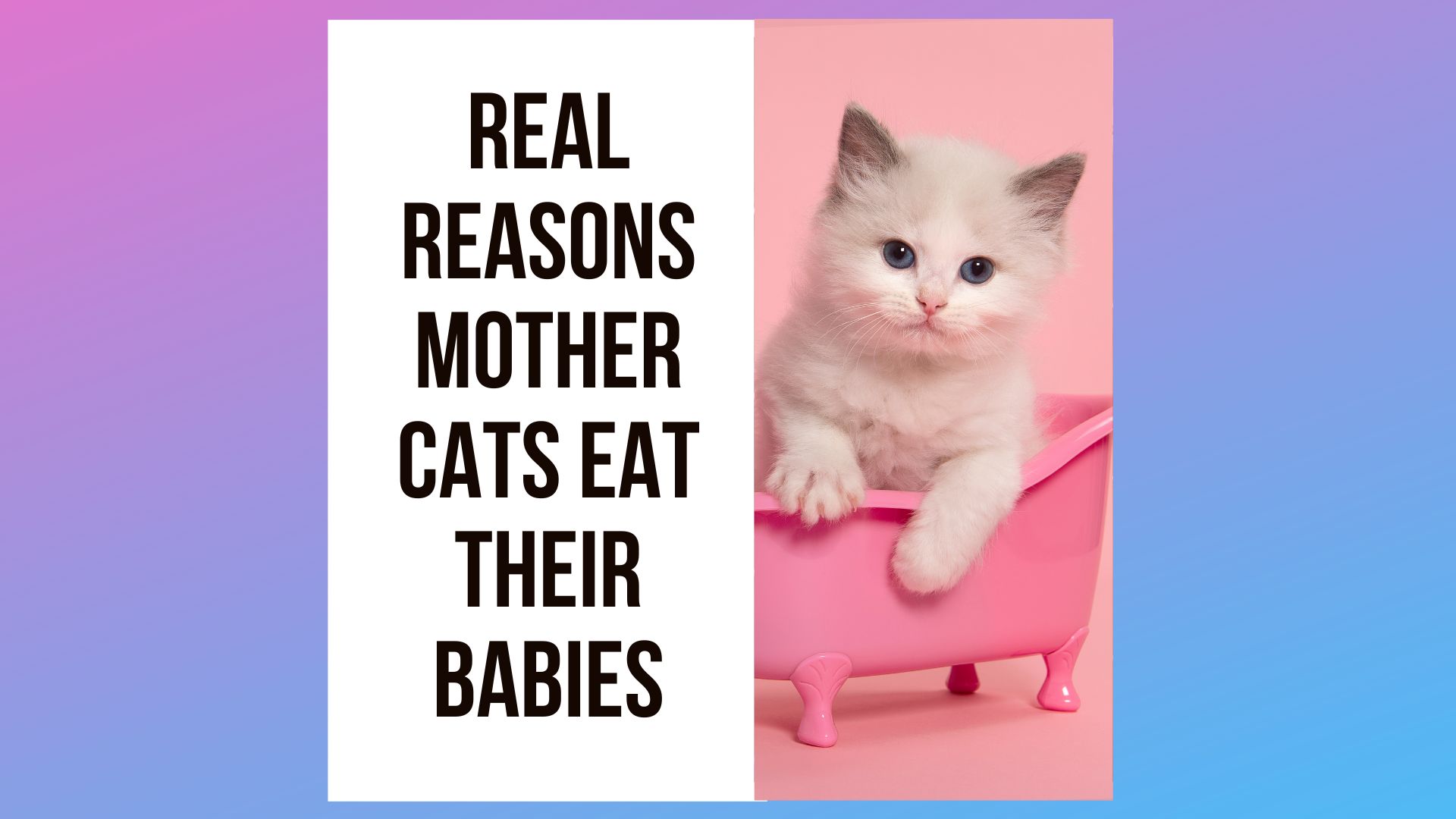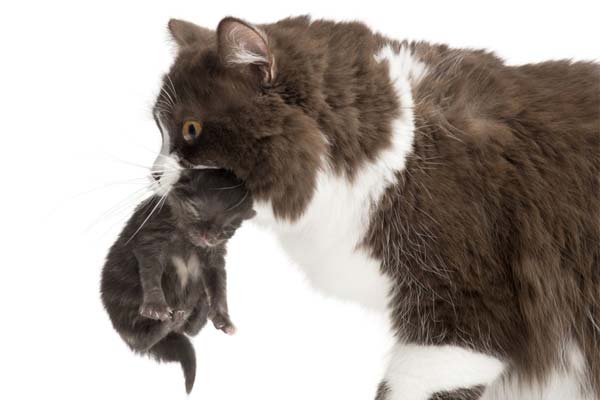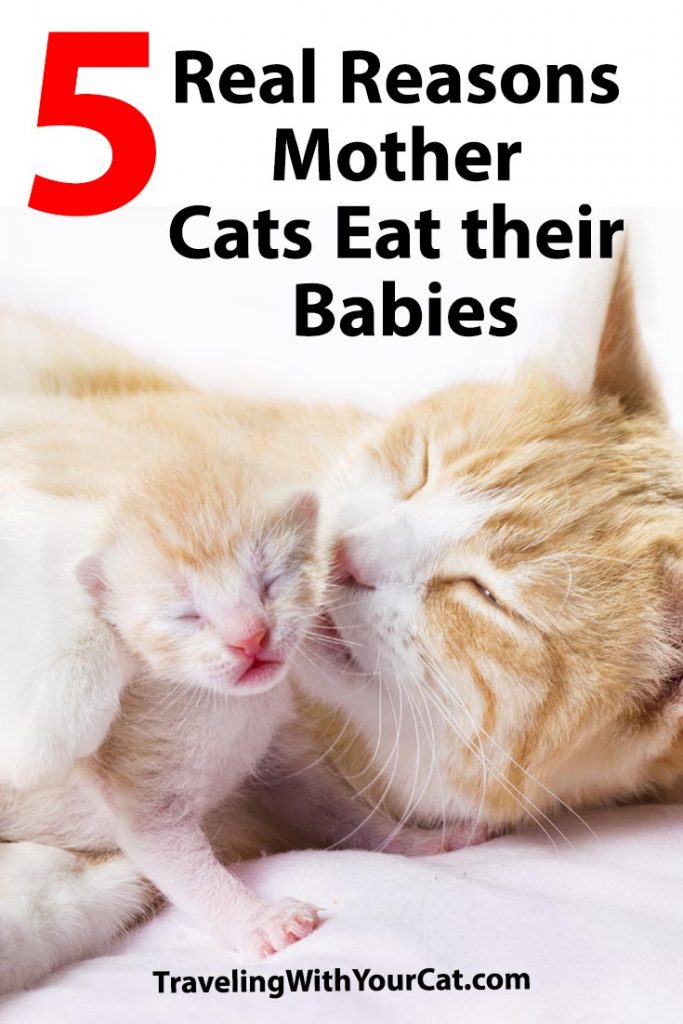
Reasons Mother Cats Eat Their Babies: Why do mother cats sometimes eat their kittens? Why Will A Mother Cat Eat Her Babies? Birth is a miracle, but are you ready for what comes afterward? Queens are mother cats, and most females have a natural nurturing instinct to love and care for their babies.
According to Reference Website, Sometimes, a mother cat does the complete opposite. She might eat one or more of her kittens. Doing so makes her no less of a mother, and it doesn’t make her a bad mother.
Is it Normal for Momma Cats to Eat their Kittens?
Yes, it is normal behavior. Some cats will eat one kitten. Others will consume their entire litter.
Science remains uncertain why a cat or another species will do what we consider barbaric. This video offers some hypotheses researchers believe could explain the behavior.
Remember, it has no bearing on you as an owner. You can’t stop or always control nature. You can, however, try to understand why and take some steps to prevent it.
Prevention isn’t a guarantee. Success will largely depend on why your mother cat would eat her kittens.

5 Reasons Mother Cats Eat Their Babies
- Stillborn
- Birth defects
- Mercy
- Threatened
- Malnourished
1. Stillborn Kittens
While it can be barbaric to watch, it’s almost second nature for your mother cat to eat her stillborn kittens. It does provide her with nutrients that she passes through her milk to the surviving kittens.
2. Birth Defects
If you recall from the video we shared, you’ll remember this as a common reason mothers will sometimes eat their babies. Cats aren’t any different.
Remember, not all mothers will consume their kittens with birth defects. Some will choose to ignore them, which means not letting them feed. If she does this, you can remove the kitten and hand-feed it.
3. Mercy
Merciful reasons are the easiest to prevent. Mother cats will eat their kittens if she believes they’re in danger from predators. Ensure your cat has a safe area for her birth and while kittens still require her for survival.
Another side of mercy is she will ensure she can produce enough milk for her litter. Your cat has a built-in instinct, much like the hamsters in the video.
If her litter is too large, she might eat a few kittens to make sure she can provide enough milk for the remainder.
4. Threatened
Limit other animals from access, including other pets your mother cat might be comfortable with already. Also, she can view other people as a threat.
Once the kittens reach weaning age, you can typically introduce them to other household pets and other people. Do so gradually so as to not overwhelm or endanger the kittens.
5. Malnourished
We see this more with strays than household cats that receive a well-balanced diet before, during, and after their pregnancy.
Pregnant cats require more nutrients, much like humans do. According to Hill’s Pet, you should feed kitten food from pregnancy until she’s weaned her kittens.
If your cat is finicky and refuses kitten food, speak with your vet about ways you can increase her fat, protein, and calorie intake.
If you’re caring for a feral queen, you can supplement her hunting to ensure she has access to a properly balanced diet until her kittens wean. Approach her nest with caution. Leave the food where you know she will find it.
Once the kittens wean, you should consider capturing and spaying or neutering her and her litter.
Other Momma Cat Behaviors that are Completely Normal
- Moving her kittens
- Rejection
- Ignores kittens
- Aggression
She’s Moving Kittens
Your mother cat might move her kittens frequently. This can be a sign that she doesn’t feel their current area is safe.
What we see as a threat might differ from your cat’s point of view. Take care to pay attention to her cues and make adjustments as needed.
She’s Rejecting Her Kittens
Some mothers might reject their litter. Others will reject one or a few of her kittens. It can occur with new and seasoned mothers.
Vets believe some factors can lead to this behavior, such as taking much human contact with kittens and birth defects.
Limit your interaction with her kittens until they’re at least four weeks old unless their lives are in danger.
She’s Ignoring Her Kittens
Ignoring kittens is not the same as rejecting them. She might sit on them. She might not allow them to feed. Generally, this response is to her environment or the people in it, including you.
Keep children away. Remove other pets from the room; don’t allow them free access to her area. Limit human interaction to one or two people.
She’s Aggressive Toward You or Others
Aggression occurs for any number of reasons, but the most likely culprit is a threat she perceives. She might hiss, growl, or attack other animals and people that come near her kittens.
Do your best to observe at a distance. Only interfere if momma or her babies require emergency attention.
Post-Partum Medical Concerns with Mother Cats
- Feline Hypocalcemia
- Endometritis or Metritis
- Mastitis
- Milk Fever
- Attached Fetal Membrane
According to VCA Hospitals, Most medical conditions will require a veterinarian for diagnosis and treatment. Failure to do so can result in death.
Feline Hypocalcemia Signs and Treatment
Feline hypocalcemia is a condition that causes low calcium levels in cats. It can occur post-partum and requires a veterinary diagnosis and immediate intervention.
Few symptoms of hypocalcemia exist in the early stages, and your vet generally discovers the low levels on a routine blood test. The good news is this is a rare condition in lactating cats.
Endometritis and Metritis Signs and Treatment
Endometritis and metritis can occur up to three days after delivery. Both are types of uterine inflammation.
Symptoms to watch for include fever, lethargy, ignoring kittens, increased thirst, and a foul vaginal discharge. She will require emergency vet care.
Mastitis Signs and Treatment
Mastitis is an inflamed mammary gland. It can occur with or without a present infection, but the condition is painful for your cat.
You can care for an uninfected gland at home by applying heat and massage to extract the milk. This generally clears the condition, and your cat resumes normal nursing.
How can you tell the difference between infected mastitis and non-infected? Look at the teat’s discharge and the teat itself.
- If the teat appears purple or deep red, it’s infected.
- If the discharge is a thick, green-yellow consistency, it’s infected.
- If your cat is running a fever, lethargic, crying out in pain, and not eating, it’s infected.
- If you notice signs of infection, you should seek out a vet immediately.
Don’t try to drain the abscess at home.
Milk Fever or Eclampsia Signs and Treatment
Between three to five weeks after delivery, your cat can develop milk fever. Calcium levels in their blood dwindle. The symptoms present as an advanced form of hypocalcemia. Both conditions are lethal if untreated.
Remove kittens and seek help at once if the mother:
- Pants heavily
- Has tremors
- Appears restless
- Convulsions occur
- She falls into a coma
Cats with large litters are most susceptible. She might require lifelong injections, and it might be wise to retire her from breeding. Most cats that have milk fever will develop it again.
Attached are Fetal Membrane Signs and Treatment
Sometimes, your cat will retain the placenta of one or more of her kittens. This occurs after her birthing process ends, but you might not notice the signs for hours after.
Symptoms vary from feline discomfort to green vaginal discharge and fever, according to PetMD. If your mother’s cat shows these signs, take her to the vet. She could require further testing and antibiotics.

What Behaviors Should Raise Concern?
During the first three weeks, your queen will usually develop any postpartum issues. Every mother is different, so you should continue to monitor her and her kittens.
With kittens, pay special attention to any that sleep more than usual. It could be a sign of fading kitten syndrome.
Veterinarians aren’t sure of an exact cause, but these kittens require immediate medical attention.
Caring for Newborn Kittens Your Mother Cat Can’t Care For
Without a surrogate mother, you become responsible and take the queen’s place until the kittens can eat and eliminate waste on their own.
This video shows how you can safely feed newborn kittens should their mother be unable to care for them.
Newborn Kitten Feeding and Care Supplies You’ll Need:
It doesn’t hurt to have these supplies on hand before your pregnant cat delivers.
Final Thoughts on Cats That Eat Their Kittens
While it’s a bit barbaric, it’s normal behavior for your mother cat to eat one or more of her kittens. She can have many reasons for doing so, which range from mercy to malnutrition.
You can’t always prevent her from doing this, and you shouldn’t stop or scold her. She has instincts that you don’t, including knowing how many kittens she can nurse.
Cats can show other odd behaviors. Pay attention and react accordingly. Your cat can only communicate her distress in so many ways.
From pregnancy to weaning, provide your mother cat with plenty of quiet space, high-quality kitten food, and water. Intervene only when necessary for a kitten or the mother’s survival.

Hi, This is Alexa, and I love cats. This Website is a Complete Journal about how to travel with a cat and other information about Cat Health, Cat Training, Cat Behavior, Cat Foods and more. I hope you find it useful.
